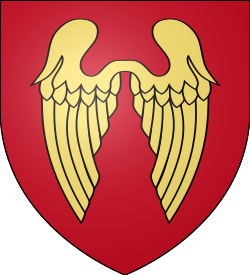John Seymour (died 1464)
Sir John Seymour (c. 1395, c. 1400 or 1402 – 20 December 1464) of Wulfhall in Savernake Forest, Wiltshire, and of Hatch Beauchamp, Somerset, was an English knight and member of parliament.

Life
He was the son of Roger Seymour (born Hatch Beauchamp, Somerset, c. 1367–1370, died 1420) by his marriage to Maud Esturney or Esturmi, daughter of Sir William Esturney or Esturmi, Speaker of the House of Commons, paternal grandson of Sir William Seymour (Hatch Beauchamp, Somerset, c. 1342 – 25 August 1391, brother of Lettice Seymour (born Rogaid, Glamorgan, c. 1343), wife of Gilbert Gamage and mother of Sir William Gamage) and wife Margaret de Brookbury or Brockbury, and great-grandson of Sir Roger St. Maur or Seymour, Kt. (Even Swindon, Wiltshire, 1314 – bef. 1361) and wife Cicely or Cecily de Beauchamp (c. 1321 – 7 June 1394). Cecily de Beauchamp inherited the manors of Hatch Beauchamp, Shepton Beauchamp, Murifield and one third of the manor of Shepton Mallet, Somerset, the manors of Boultbery and Haberton, Devon, of Dorton, Buckinghamshire, and of Little Haw, Suffolk, and was a daughter of Sir John de Beauchamp, 2nd Baron Beauchamp, (of Somerset) and wife Margaret St John, and married secondly on 14 September 1368 Sir Gilbert Turberville of Coity, Glamorgan.[1][2]
He was elected Member of Parliament for Ludgershall in 1422 and Knight of the Shire for Wiltshire in 1435, 1439, and 1445.[3] He was also High Sheriff of Wiltshire in 1431–1432, having previously served as High Sheriff of Hampshire.[4]
A tenement in Redcliffe Street, Bristol, was held by Sir John Seymour, Knight, in 1454, and by the Lady de Seymour in 1469.[5]
Marriage and issue
He married on 20 or 30 July 1424 Isabel William or Williams (died 14 April 1486), daughter of Mark William, a merchant and Mayor of Bristol,[6] in some sources given as William Mac William or Williams of Gloucestershire,[7] and had two children:
- John Seymour (1425–1463)
- Margaret Seymour (born c. 1428), married Edmund (Edward) Blount
As his son predeceased him, Seymour was succeeded in his estates by his grandson, another John Seymour.
After her husband's death in 1464, Isabel took vows of chastity.[8]
References
- G.E. Cokayne; with Vicary Gibbs, H.A. Doubleday, Geoffrey H. White, Duncan Warrand and Lord Howard de Walden, editors, The Complete Peerage of England, Scotland, Ireland, Great Britain and the United Kingdom, Extant, Extinct or Dormant, new ed., 13 volumes in 14 (1910–1959; reprint in 6 volumes, Gloucester, U.K.: Alan Sutton Publishing, 2000), volume II, p. 50.
- Peter W. Hammond, editor, The Complete Peerage or a History of the House of Lords and All its Members From the Earliest Times, Volume XIV: Addenda & Corrigenda (Stroud, Gloucestershire, U.K.: Sutton Publishing, 1998), p. 76.
- J. S. Roskell, The Commons in the Parliament of 1422 (Manchester University Press), p. 126 (see footnotes)
- Mervyn Archdall, The Peerage of Ireland, p. 16
- Wiltshire notes and queries, vol. 2 (1899), p. 589
- Douglas Richardson, Kimball G. Everingham, Magna Carta ancestry: a study in colonial and medieval families (2005), p. 554
- Thomas Nicholas, Annals and Antiquities of the Counties and County Families of Wales (1991), p. 194
- Amy Audrey Locke, The Seymour family (Houghton Mifflin, 1914), p. 5